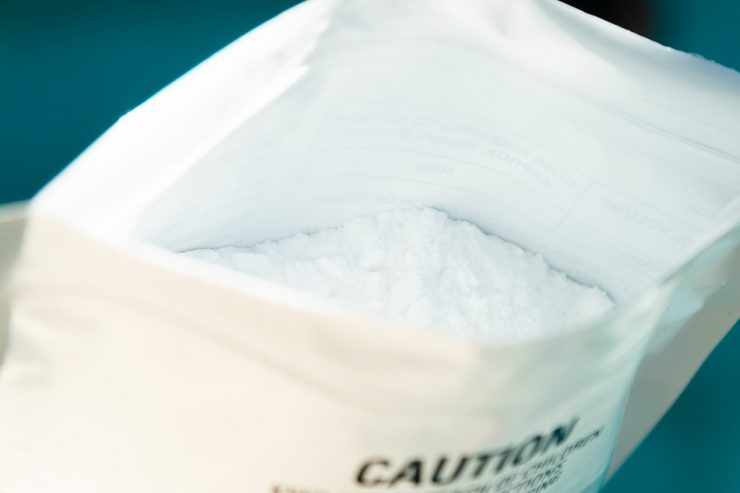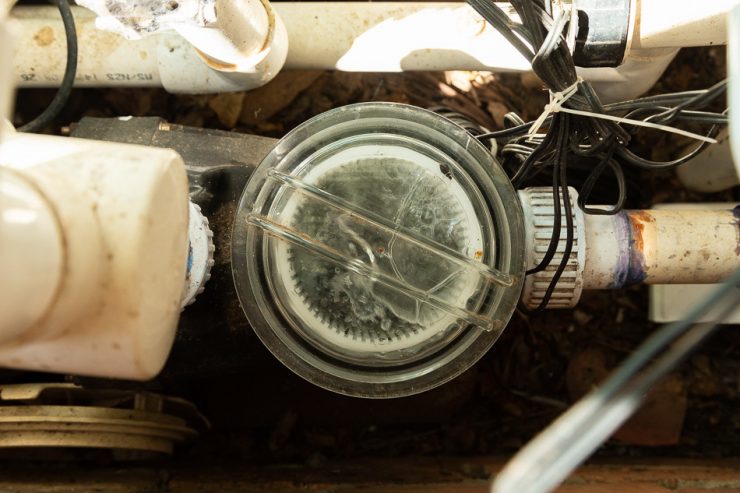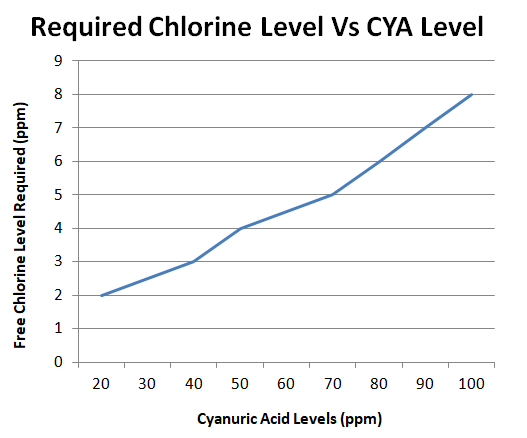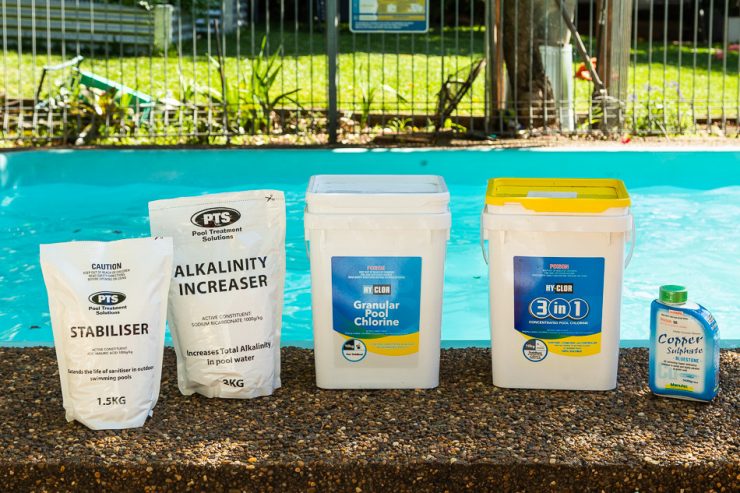If you’ve just tested your pool water and found high cyanuric acid levels and you’re not sure how to lower cyanuric acid in your pool, I’ve got you covered in this article. And if you’re having a problem where the cyanuric acid level keeps going up or stays high, I’ll help you solve that too.
If you don’t know what cyanuric acid (CYA for short) is, it’s a chemical used to stabilize the chlorine in your pool. Without it, you would be spending a lot more money buying chlorine and constantly adding it.
Cyanuric acid is also known as pool stabilizer and pool sunscreen. It can be purchased as a separate chemical or it can be found as an additive in some chlorine (stabilized chlorine often sold as dichlor) and shock products.

Article Contents
How to Lower Cyanuric Acid in Your Pool
Let’s cut straight to the chase. Here’s exactly how to lower stabilizer in a pool:
Step 1) Drain some of the pool water (to waste).
Step 2) Top the pool back up to normal levels.
Step 3) Run your pump for a few hours to circulate the water and mix the fresh water in with the existing water.
Step 4) Retest the cyanuric acid / pool stabilizer levels again. Repeat this process if the levels are still too high.
How Much Pool Water Should You Drain?
Lowering cyanuric acid in your pool by removing pool water isn’t an exact science. (Well it could be calculated but it’s easier to estimate the amount of water to remove).
The action of removing water and topping the pool back up again will do two things.
Firstly, when you drain part of the water, the water that was removed contains cyanuric acid. The second thing is the concentration of pool stabilizer in the pool water will be diluted when you top up the pool water to normal levels again.
As an example of how much water to remove, if your chlorine stabilizer levels are too high, say by 10%, then you’ll need to remove roughly 10% of the water. Next, refill the pool to dilute the cyanuric acid (CYA) levels and bring the pool water levels back up to where they should be.
Now run the pump for 1-2 hours to mix the new water and test for pool stabilizer levels again. You may need to do this in batches.

Warning: do not drain more than 1/3 of your pool at a time without consulting a pool professional. Draining more than this can result in hydrostatic damage. Hydrostatic damage is when your pool shifts or pops slightly out of the ground which can mean cracking and other major structural damage.
What if you don’t want to drain the pool? There is a newish product on the market that reduces cyanuric acid levels in pools.
You can read about it here:
What is a Cyanuric Acid Reducer and Does It Work?
Is High Cyanuric Acid Bad in the Pool?
Yes, having high cyanuric acid and high chlorine stabilizer in your pool is bad. Here’s why.
The effects of high cyanuric acid aren’t a concern for your health particularly. The main issue when cyanuric acid is too high is chlorine becomes less effective. The higher the levels of cyanuric acid, the more free chlorine is needed to maintain the same level of protection.

As you can see in the above image, the higher the cyanuric acid levels in the pool the more free chlorine is needed to kill off unwanted bacteria. You’ll need twice the amount of chlorine for high stabilizer levels of 100 ppm.
Without the chlorine working properly, you’ll likely start getting algae problems. Not only that, you risk other bacteria that are harmful to your health growing in your pool – and no one wants to get sick.
Cyanuric Acid Levels Too High – How High is Too High?
Stabilizer levels are too high when they’re above 50 ppm for a chlorinated pool and 60 ppm for a saltwater swimming pool.
However, I wouldn’t be too concerned if your CYA levels are 55 or 65 ppm. But if they are creeping higher than this, you would be wise to reduce cyanuric acid levels in your pool.
Keep in mind that some test kits will not even register the cyanuric acid levels if it is excessively high (over 100 ppm).
Ideal Cyanuric Acid (CYA) Level Pools
The correct stabilizer levels for a chlorinated pool is 30-50 ppm and 60 ppm for a saltwater swimming pool.
You could have higher or lower stabilizer levels in your pool but you would need to adjust the amount of chlorine accordingly. The higher the stabilizer levels the more chlorine you’ll need.
However, there isn’t a lot of point having high cyanuric acid levels as its effectiveness as a stabilizer doesn’t really increase a lot above the ideal levels.
Unless you have a good reason, the best cyanuric acid and pool stabilizer levels are as mentioned above. In our other article, Cyanuric Acid for Pools – The Complete Guide for Pool Owners, you can see a chart of Chlorine Vs Cyanuric Acid levels.
Why is Pool Cyanuric Acid High?
If you’re wondering why you have too much cyanuric acid in your pool or if you’ve found that the CYA is constantly too high, this is for you.
Cyanuric acid does not evaporate or degrade like chlorine and other chemicals do. It will stay in the pool water.
In fact, cyanuric acid has been known to stay in pools even after completely draining them – it can get into the plaster. The only way to lower the levels is to drain some water and add water with no CYA in it.
What to do if Cyanuric Acid Stays High
The first thing to do is to check the type of chlorine and pool shock products you’re using.

Products marketed as stabilized chlorine and some pool shocks all have cyanuric acid added. The ingredients may be names such as:
- trichloroisocyanurate
- sodium dichloroisocyanurate
- potassium dichloroisocyanurate
- trichlor
- dichlor
If you’re using any of these, stop using them for a while and switch to chlorine products without any cyanuric acid added to it.
Over time, with the reduction of water (through evaporation and splashing) and topping up of water in your pool, the CYA levels should reduce. Or as mentioned above, for a quicker reduction in stabilizer levels, drain some of the pool water.
You should also check the water level of your pool. If your pool level is lower than it should be, this can result in a higher relative concentration of CYA. Top up your water if it’s low and this will dilute the CYA. Then circulate the pool water for a few hours and retest.
If this still doesn’t solve the problem, the final thing to check is that you’re using an accurate testing method. Buy a quality water testing kit and test again. Or you can take a sample of pool water to your local pool store for testing.
Summary
High cyanuric acid in pools is a problem and is something you need to make sure you take care of. The easiest and fastest way to reduce CYA in your pool is to drain some of the water from your pool and then top it back up again.
If you still find the cyanuric acid levels are too high or keep increasing, make sure you’re not using chlorine or shock with added cyanuric acid or stabiliser.
You may also have the opposite problem, low cyanuric acid. If you do, check out our article: How To Raise Cyanuric Acid.
If you follow this advice, the cya levels in your pool will be normal in no time.
Happy Swimming!
Recommended Products
Cyanuric Acid – granular form
Cyanuric Acid – liquid form
Related Reading:
Cyanuric Acid for Pools – The Complete Guide for Pool Owners

